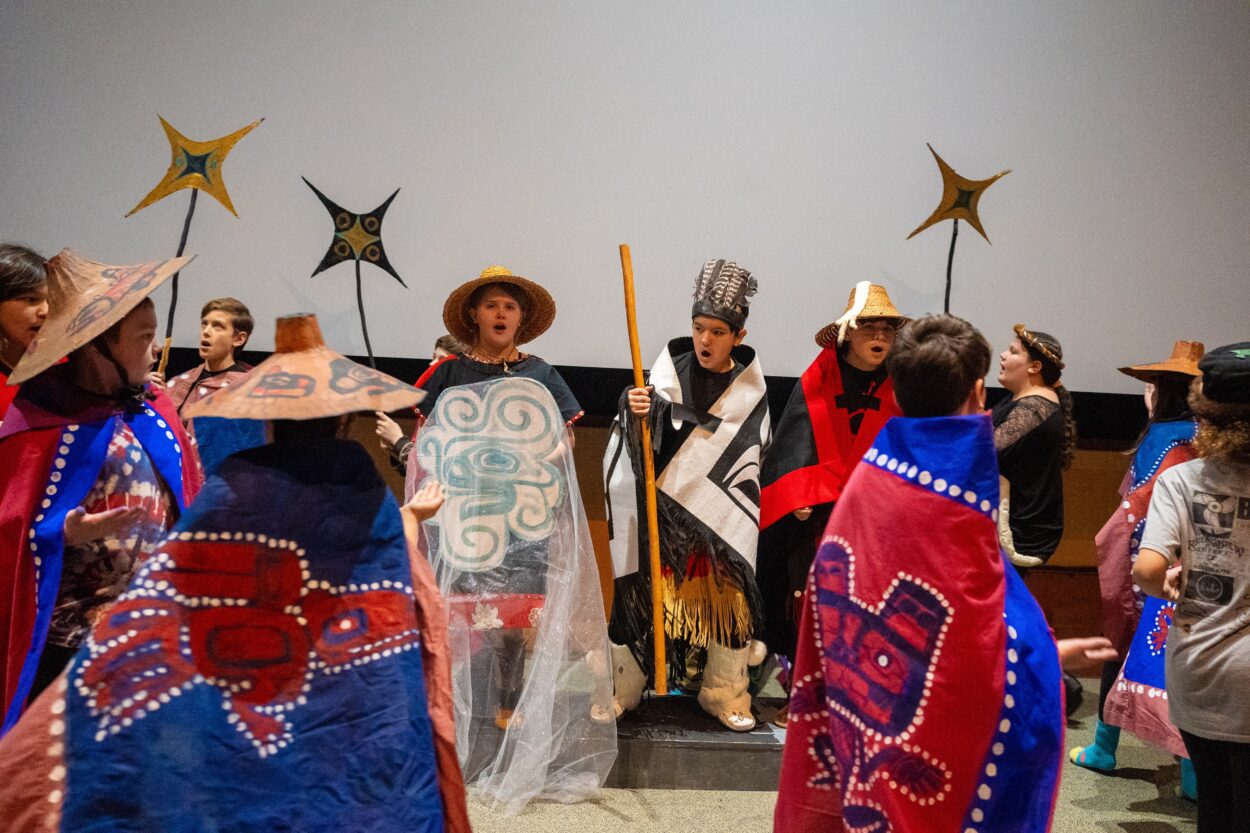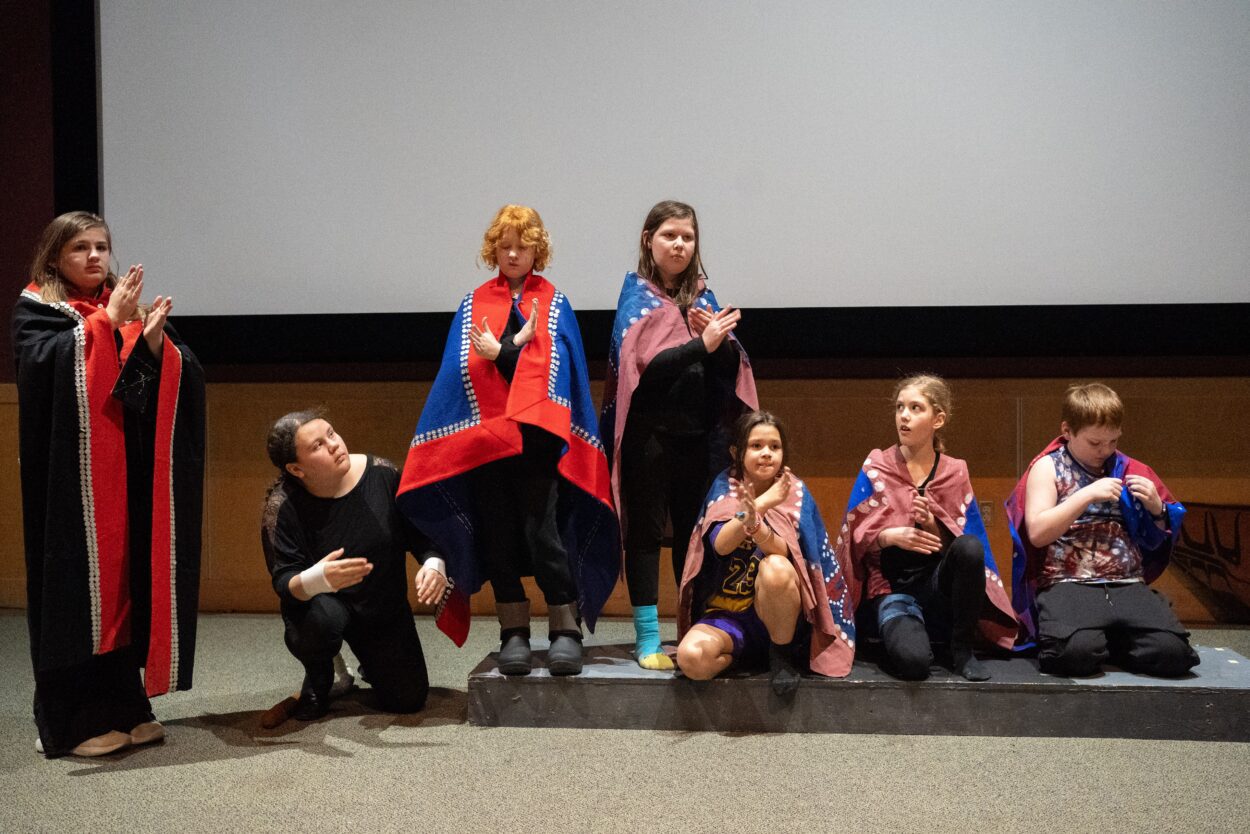
On the Friday afternoon of Ketchikan students’ spring break, 12-year-old Dominic Blair stood at a podium in the back of the Discovery Center performance hall. He was one of four narrators of the play “The Origin of Sun, Moon, and Fog.”
“It was in the beginning before anything that lives in our world was created,” Blair read from a binder on the podium. “There was only the chief in heaven. There was no light in the sky, there was only darkness…”
The play came from a traditional Tsimshian story. While others were on vacation or at home playing video games, about two dozen students spent their spring break rehearsing a theater production. Over the course of five days, the pre-teens learned lines, cues, song and dance. Friday was the last day of rehearsal before their big performance that evening.
After they finished practicing, Blair was feeling excited but a little apprehensive.
“I just hope it goes well,” he sighed.
Blair proudly explained he’s Tsimshian and Tlingit, and an Eagle. He said he enjoyed the process of learning a traditional story, but that live production isn’t without its challenges.
“Sometimes I would get done narrating my part, and then Narrator Two would come up, and then I was going to try to get some water but then it’d be my turn, my part already,” he explained.
The spring break camp is part of a program called Voices on the Land, put on by the Sealaska Heritage Institute (SHI). SHI’s mission is to perpetuate and enhance the Native cultures of Southeast Alaska, and this educational program does that by immersing students in visual and performing arts, all through an Indigenous lens.
Mansyndoga da Gyet Nancy Barnes has been working for SHI for eight years, coordinating their education projects.
“I’ve watched these camps over the years, and it makes a difference,” Barnes said. “I’ve seen it myself. It’s made a difference in young people’s, our children’s lives. And it gives them confidence, knowing who they are. They have a camaraderie, the group, even later.”
Dominic Blair seemed to agree, calling the week of working with his peers, “amazing.”
“I’m just really happy to meet all these new people and to work with these people,” Blair said. “To know that they worked so hard, as well as I did.”
Blair said he’s glad it came together because he initially questioned whether he should even take part. Once his cousin said she would do it with him, he was sold.
“It has been a whole ride,” he said. “And I’ve been really happy I was able to do this play.”

Torah Zamora was the person behind the scenes making it all happen. Born and raised in Ketchikan, she said her great-grandmother was part of the migration to Metlakatla from Tsimshian territory.
“And then she moved here to Ketchikan, my great grandma Selena Eaton,” Zamora explained. “And raised her kids [in the] Creek Street area.”
Zamora started an apprenticeship with SHI last year, focused on education through performing arts. As part of that, she put together this spring break camp, teaching 4th, 5th, and 6th graders how to act out a play.
She said the story was documented by a Tsimshian man named Henry Tate, who worked with anthropologist Franz Boas to translate it into English in the early 1900s.
Zamora, in turn, took that antiquated English story and adapted it into a performance that would make sense to kids. She also added a personal touch to it.
“At the very end of the play, when they go ‘gawdy!’ that’s more my own little plug in there, because it’s a word my grandma would still speak throughout life,” Zamora said. “But it was mostly like after she fed her dogs treats, she would say, ‘gawdy!’ which means like ‘all gone, all done!’ And so it’s just a tribute to my grandmother.”
Zamora said her grandmother’s first language was Sm’algyax, the Tsimshian language. But because she was forcefully, often violently, punished for speaking it, she didn’t teach it to her children.
“Just two generations ago, my grandmother wasn’t allowed to speak Sm’algyax,” Zamora said. “Which implies she was not allowed to be her Native self, she wasn’t allowed to celebrate her Tsimshian identity, and all that knowledge that comes with it.”
Zamora said even her own Tsimshian identity wasn’t celebrated when she was in school less than 10 years ago. It still wasn’t “cool” to be Native, as she puts it. In recent years though, she’s noticed things have started to change.
“We’re seeing this shift in our generation, in young people now, where it is something to value and we can speak it in school now,” she said. “We can learn it and teach it. And it’s this shift to reclaiming it and bringing it back into our daily lives.”
Opportunities like this performing arts camp, she said, are a rare chance for kids to embrace their true Indigenous selves, uplifting the language and storytelling tied to that identity.
The camp was open to the public, with priority given to Alaska Native students. Zamora said a few participants were non-Native, but they did great learning all the songs and dances. She said these cultural traditions are something the entire community should be familiar with.
“Because if you’re living here in Ketchikan, Kichx̱áan, or anywhere in Southeast Alaska, you should have knowledge of the Indigenous history of this land and the people who still live here and reside,” Zamora said. “It enriches all of our lives.”
The performers were expecting a full house at the Discovery Center for their Friday night showcase, with a livestream provided by the U.S. Forest Service for viewers checking in from as far away as Mexico.





